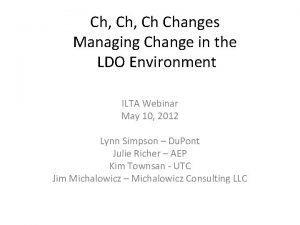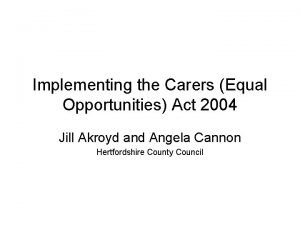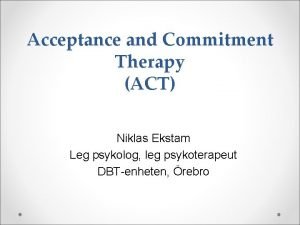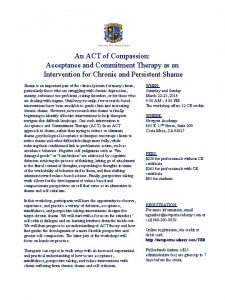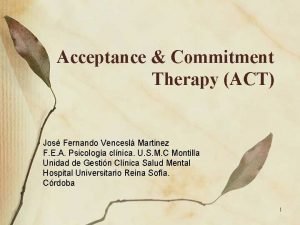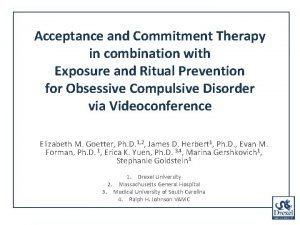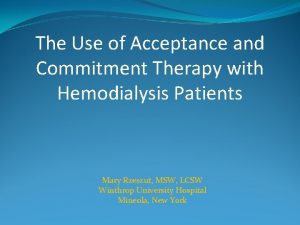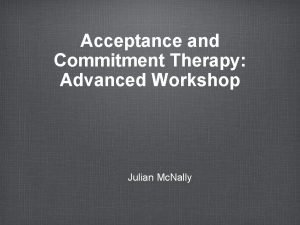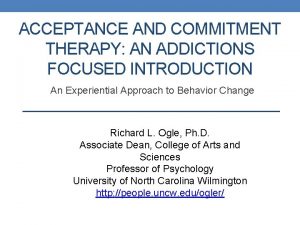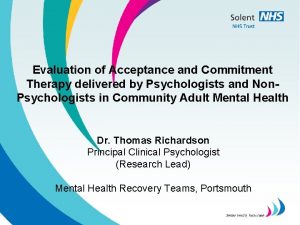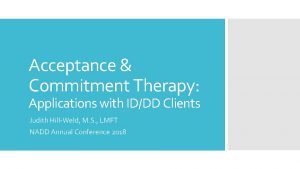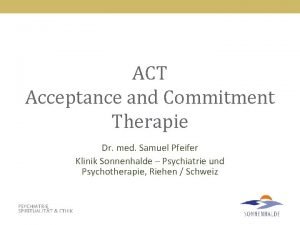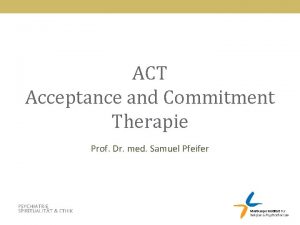Opportunities in Acceptance and Commitment Therapy ACT for


















































- Slides: 50

Opportunities in Acceptance and Commitment Therapy (ACT) for Enhancing Evidence-based Chaplaincy Jason A. Nieuwsma, Ph. D Associate Director, VA Mental Health and Chaplaincy Associate Professor, Duke University Medical Center Durham, NC

Objectives 1. Describe how evidence-based principles in ACT can be highly synergistic with commitments in healthcare chaplaincy. 2. Employ key practices from ACT to deepen the provision of patient-centered spiritual care. 3. Explore how using ACT principles can enhance capacities for participating as a member of integrated care teams.

I undertook great projects: I built houses for myself and planted vineyards. I made gardens and parks and planted all kinds of fruit trees in them. I made reservoirs to water groves of flourishing trees. I bought male and female slaves and had other slaves who were born in my house. I also owned more herds and flocks than anyone in Jerusalem before me. I amassed silver and gold for myself, and the treasure of kings and provinces. I acquired male and female singers, and a harem as well—the delights of a man’s heart. I became greater by far than anyone in Jerusalem before me. I denied myself nothing my eyes desired; I refused my heart no pleasure… Yet when I surveyed all that my hands had done and what I had toiled to achieve, everything was meaningless, a chasing after the wind; nothing was gained under the sun. - Ecclesiastes

“The single most remarkable fact of human existence is how hard it is for human beings to be happy. ” - Steven C. Hayes

Why do we suffer?

At a recent Rockefeller Foundation seminar on the concept of health, one authority urged that medicine "concentrate on the 'real' diseases and not get lost in the psychosociological underbrush. The physician should not be saddled with problems that have arisen from the abdication of theologian and the philosopher”…I do not accept such a premise. - George Engel, Science (1977)

How do we stop suffering?

Beck Depression Inventory-II (BDI-2)

What success looks like on BDI-2 Treatment Control 30 BDI-2 25 20 15 10 5 0 1 6 12 Week 24

Acceptance & Action Questionnaire-II (AAQ-2)

What success looks like on AAQ-2 Treatment Control 30 25 20 15 10 5 0 1 6 12 Week 24

What does “success” look like in faith?

Control as a means to achieving success CAN’T CONTROL �Examples CAN CONTROL �Examples 13

Tug of War with a Monster What to do? Drop the rope!

Paradox �ACT Being accepting of negative leads to feeling more positive. �Faith tradition examples: The last shall be first. Lose your life to gain it. Reality is not reality. For neither is the aim “happiness” or “feeling good, ” and yet that effect frequently occurs. 15

Acceptance and Commitment Therapy (ACT) What is ACT? �Related to CBT family of treatments �Acceptance: Willingness to experience �Commitment: Living in line with values

ACT Defined The ACT care provider works to help the patient accept internal events (thoughts, emotions, memories, and sensations) while also helping the patient to make and keep behavioral commitments that reflect the patient’s personal values. Oversimplified, you might say: hold and move. “Hold” your experience, whatever it may be, and “move” forward in your life. The objective of ACT is to foster psychological flexibility. Psychological flexibility can be summarized as contacting the present moment fully as a conscious human being, experiencing what is there to be experienced and working to change behavior such that it is in the service of chosen values.

ACT: Is there “Value-Added? ” �ACT challenges conventional cognitive-behavioral approaches to… The assumption of “healthy normality” The patient/provider dichotomy The role of thoughts The significance of values Measurement

Why ACT for Interdisciplinary Care? � Evidence-based 1, 2 Over 250 RCTs show ACT ≥ TAU 3, 4 Works for: Bio–Psycho–Social Health 300 250 200 150 100 50 0 Cummulative ACT RCTs 2000 2001 2002 2003 2004 2005 2006 2007 2008 2009 2010 2011 2012 2013 2014 2015 2016 2017 2018 � Principle-based Flexible theory, not fixed protocol Not confined to particular disorder � Synergistic with cultural perspectives/worldviews Values-centric Embraces major religious practices Human flourishing, not absence of disease � A broad tent Providers Patients 1. Powers, M. B. Zum Vörde Sive Vörding, et al. (2009). "Acceptance and commitment therapy: A meta-analytic review. " Psychotherapy and Psychosomatics 78(2): 73 -80. 2. Ruiz, F. J. (2010). "A review of Acceptance and Commitment Therapy (ACT) empirical evidence: Correlational, experimental psychopathology, component and outcome studies. " International Journal of Psychology & Psychological Therapy 10(1): 125 -162. Searches conducted on January 3, 2019. ACBS keeps an ongoing count of published and “in press” RCTs on ACT (https: //contextualscience. org/ACT_Randomized_Controlled_Trials). As of November 2018, there were 265 published RCTs on ACT. 3. 4.

Premises of ACT �Psychological pain is normal, it is important, and everyone has it. �You cannot deliberately get rid of your psychological pain, although you can take steps to avoid increasing it artificially. �You can live a life you value.

Six Aims of ACT For patient/provider to: 1. Be in the present moment. 2. Accept what is. 3. Watch your thinking. 4. Be aware of yourself. 5. Know your values. 6. Carry out valued behavior.

The ACT Model Contact with the Present Moment Acceptance Values Cognitive Defusion Committed Action Self as Context

The ACT Model Opening Up Developing Awareness Doing What Matters

Acceptance Opening up and making room for painful feelings, sensations, urges, and emotions.

Acceptance In ACT, acceptance is not a passive resignation but an active acknowledgment. Acceptance = Willingness 25

Want to panic? Levitt, J. T. , T. A. Brown, et al. (2004). "The Effects of Acceptance Versus Suppression of Emotion on Subjective and Psychophysiological Response to Carbon Dioxide Challenge in Patients With Panic Disorder. " Behavior Therapy 35(4): 747 -766. 26

Want to do it again? Levitt, J. T. , T. A. Brown, et al. (2004). "The Effects of Acceptance Versus Suppression of Emotion on Subjective and Psychophysiological Response to Carbon Dioxide Challenge in Patients With Panic Disorder. " Behavior Therapy 35(4): 747 -766. 27

Cognitive Defusion Learning to “step back” and separate or detach from our thoughts, images, and memories.

Don’t think about…. 29

CHOCOLATE CAKE 30

Leaves on a Stream https: //www. mindfulnessmuse. com/wp-content/uploads/2011/09/Cognitive-Defusion-Exercise-1. pdf

The ACT Model Opening Up Developing Awareness Doing What Matters

Contact with the Present Moment Consciously connecting with and engaging in whatever is happening in this moment.

Contact with Present Moment �About “therapist” as much as “client” �Not just meditation �Mindfulness: “paying attention in a particular way: on purpose, in the present moment, and non-judgmentally” (Kabat-Zinn) Nice, but…

A Different Approach to Past, Present, & Future �Instead of… re-hashing the past to make sense of the present in order to predict the future… �ACT seeks to… minimize the distraction of dwelling in the past or fantasizing about the future in order to live richly in the present.

Self as Context Developing awareness of the “observing self” that is aware of what we’re thinking, feeling, sensing, or doing in any moment.

Three Senses of Self �Conceptualized self Self-concept; self-description “Who I am” as a person �Self-as-awareness Ongoing process of noticing our experience Contacting present moment �Self-as-context Space from which “noticing” happens (the “observing self”) The “I” (as opposed to “me”)

The Pieces and the Board

The Continuous You

The ACT Model Opening Up Developing Awareness Doing What Matters

Values Knowing and clarifying desired qualities of ongoing actions, or chosen life directions.

Values �In ACT, values: 1. 2. 3. 4. 5. are here & now. are not about being justified. often need to be prioritized. are best held lightly. are freely chosen.

Committed Action Taking effective action, guided by our values, even in the face of pain and discomfort.

Commitment Values Goals Direction Destination Process-oriented Outcome-oriented Intangible Tangible Can’t check off Can check off

The Willingness & Action Plan


Act Longfellow, A Psalm of Life 47


Questions?

Recommended ACT Readings � Hayes, S. C. & Lillis, J. (2012) Acceptance and Commitment Therapy. � � Washington, DC, American Psychological Association. Hayes, S. C. (2005). Get Out of Your Mind and Into Your Life: The New Acceptance and Commitment Therapy. Oakland, CA, New Harbinger Publications. Wilson, K. G. (2008). Mindfulness for Two. Oakland, CA, New Harbinger Press. Harris, R. (2009). ACT Made Simple: A Quick-Start Guide to ACT Basics and Beyond. Oakland, CA, New Harbinger Press. Nieuwsma, J. A. , Walser, R. D. , & Hayes, S. C. (Eds. ). (2016). ACT for clergy and pastoral counselors: Using acceptance and commitment therapy to bridge psychological and spiritual care. Oakland, CA: Context Press / New Harbinger Publications. � Worksheets available at: http: //www. thehappinesstrap. com/free_resources
 Change curve+awareness+understanding+acceptance+commitment
Change curve+awareness+understanding+acceptance+commitment Psychodynamic and humanistic therapies have in common
Psychodynamic and humanistic therapies have in common Bioness bits cost
Bioness bits cost Humanistic therapy aims to
Humanistic therapy aims to Macbeth summary
Macbeth summary Equal opportunities act 2004
Equal opportunities act 2004 Missouri physical therapy practice act
Missouri physical therapy practice act Formuö
Formuö Typiska novell drag
Typiska novell drag Nationell inriktning för artificiell intelligens
Nationell inriktning för artificiell intelligens Vad står k.r.å.k.a.n för
Vad står k.r.å.k.a.n för Shingelfrisyren
Shingelfrisyren En lathund för arbete med kontinuitetshantering
En lathund för arbete med kontinuitetshantering Särskild löneskatt för pensionskostnader
Särskild löneskatt för pensionskostnader Tidbok för yrkesförare
Tidbok för yrkesförare A gastrica
A gastrica Densitet vatten
Densitet vatten Datorkunskap för nybörjare
Datorkunskap för nybörjare Boverket ka
Boverket ka Att skriva debattartikel
Att skriva debattartikel För och nackdelar med firo
För och nackdelar med firo Nyckelkompetenser för livslångt lärande
Nyckelkompetenser för livslångt lärande Påbyggnader för flakfordon
Påbyggnader för flakfordon Tryck formel
Tryck formel Publik sektor
Publik sektor Lyckans minut erik lindorm analys
Lyckans minut erik lindorm analys Presentera för publik crossboss
Presentera för publik crossboss Teckenspråk minoritetsspråk argument
Teckenspråk minoritetsspråk argument Kanaans land
Kanaans land Treserva lathund
Treserva lathund Fimbrietratt
Fimbrietratt Bästa kameran för astrofoto
Bästa kameran för astrofoto Centrum för kunskap och säkerhet
Centrum för kunskap och säkerhet Verifikationsplan
Verifikationsplan Mat för idrottare
Mat för idrottare Verktyg för automatisering av utbetalningar
Verktyg för automatisering av utbetalningar Rutin för avvikelsehantering
Rutin för avvikelsehantering Smärtskolan kunskap för livet
Smärtskolan kunskap för livet Ministerstyre för och nackdelar
Ministerstyre för och nackdelar Tack för att ni har lyssnat
Tack för att ni har lyssnat Hur ser ett referat ut
Hur ser ett referat ut Redogör för vad psykologi är
Redogör för vad psykologi är Stål för stötfångarsystem
Stål för stötfångarsystem Atmosfr
Atmosfr Borra hål för knoppar
Borra hål för knoppar Vilken grundregel finns det för tronföljden i sverige?
Vilken grundregel finns det för tronföljden i sverige? Varians formel
Varians formel Tack för att ni har lyssnat
Tack för att ni har lyssnat Steg för steg rita
Steg för steg rita Vad är verksamhetsanalys
Vad är verksamhetsanalys Tobinskatten för och nackdelar
Tobinskatten för och nackdelar
